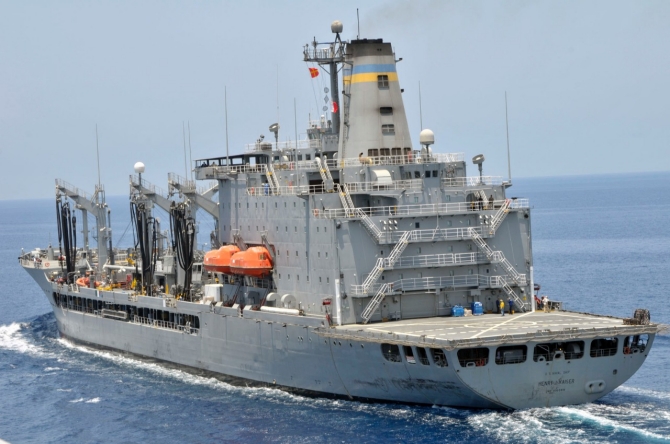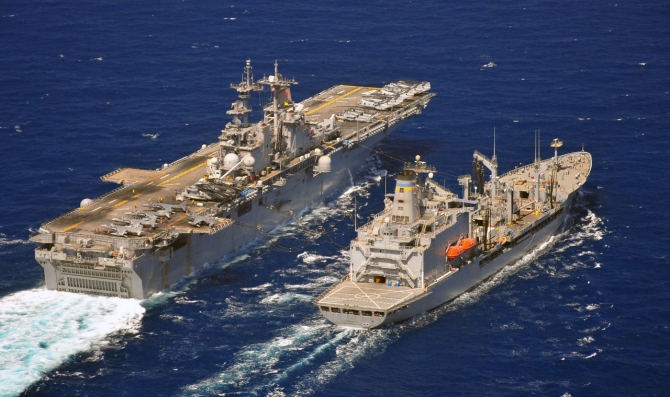Henry J. Kaiser (T-AO-187)
1985–
U.S. Navy ship named in honor of Henry John Kaiser (9 May 1882–24 August 1967) whose impact on American industry was remarkable. He is known as the "father of modern shipbuilding" and was considered the most powerful businessman in the United States during World War II. The concrete he manufactured went to build Pacific military bases, his aluminum into new advanced warplanes, his steel into warships and the thousands of cargo ships he built carried troops and supplies across the oceans to the European and Pacific Theaters. The electricity generated by the dams he built fueled the West Coast war industries. Kaiser became a favorite of the news media and was considered by many to be the most influential civilian to help America win the war.
Of the many businesses Henry Kaiser founded during his career, he is best known for his World War II shipbuilding yards. In 1941 under the Emergency Shipbuilding Program, the U.S. Maritime Commission (USMC) began a massive expansion of the merchant marine fleet. A central part of the program was a standard design cargo ship known as a Liberty Ship. At first the USMC planned to construct 60 ships for the British, which eventually expanded to 112. The first Liberty Ship was completed on 27 September 1941 and over the next year, Kaiser shortened the time of production from 197 days for each ship to 14 days. The record was 4 days, 15 hours, and 30 minutes.
Each of the 441 foot-long ships cost nearly two million dollars. Each could carry nine thousand tons of cargo inside its hull and airplanes, tanks or other equipment on its deck. A Liberty Ship could carry 2,840 jeeps, 440 tanks, or 230 million rounds of rifle ammunition. A crew of 44 manned the ship and 20 Naval Armed Guards operated the nine large guns fitted for defense.
Constituting the largest production program for a single type of ship, a total of 2,710 Liberty Ships were built by sixteen shipyards in the United States. Another 119 revised Liberty Ships were also produced. The ships were built in assembly-line fashion and made from parts prefabricated at various other locations. Kaiser's seven yards built 821 Liberty Ships and 219 Victory Ships, a slightly improved version of Liberty Ships. Liberty Ships comprised 27 percent of total World War II shipping. Of the 2,710 built, only 200 were lost in action.
When a ship was completed, its crew boarded the same day and they got underway to join one of hundreds of convoys crossing the Atlantic or Pacific Oceans. The ships were named after prominent deceased Americans, with Virginian Founding Father Patrick Henry being the first. Any organization that raised enough money through the sale of war bonds to fund construction of a Liberty Ship could provide a name.
Though highly successful and nearing the age of sixty, Kaiser was further propelled into national prominence with the outbreak of World War II. As German forces expanded through Western Europe in early 1940, he became concerned about the limited U.S. industrial capacity, especially for steel and aluminum production. He also believed that if the United States were drawn into the war a great demand for shipping would exist. As a result, Kaiser became outspoken about mobilizing U.S. industry. Mobilization became the key word used to describe converting American industry from peacetime to wartime uses. Through his efforts, he built a close friendship with President Roosevelt.
As the war in Europe expanded, Great Britain looked to the United States for much needed supplies. In December 1940 Kaiser and two partners won a government contract to build 30 cargo ships for the British. For this project he built a large shipyard in Richmond, Ca. and used workers from the Grand Coulee Dam project. Though he had no previous experience in shipbuilding, his industrial production genius led to national fame. His shipyards were the first to build a ship in separate sections prior to final assembly and to weld steel plates together instead of using rivets. In late 1940, Kaiser also won a government contract from the Defense Plant Corporation to build aluminum plants on the West Coast to supply aluminum for aircraft manufacturers. More contracts followed in 1941 from the U.S. maritime commission. He built another large shipyard near Portland, Or. and established the town of Vanport in 1942 for the workers. In all, Kaiser ran seven shipyards during the war, employing some two hundred thousand workers. His shipyards built 1,490 ships, including 1,112 cargo ships and 107 warships. The warships included 50 small aircraft carriers. He built one-third of the nation's cargo ships for the war.
Kaiser was the subject of hundreds of magazine articles and the media referred to him as the "Miracle Man" and America's "Number One Industrial Hero." President Roosevelt even considered naming Kaiser as his running mate for the 1944 presidential elections. In a public poll conducted near war's end in the spring of 1945, Americans named Kaiser as the American civilian who had done the most to help win the war. A 1946 public poll named Kaiser a strong prospect for U.S. president.
(T-AO-187: displacement 9,500; length 677'; beam 97'; draft 35'; speed 20 knots; complement 103; armament 1 .50-caliber machine gun, 2 20 millimeter Phalanx close in weapon systems (CIWS); class Henry J. Kaiser)
Henry J. Kaiser was laid down on 22 August 1984 at New Orleans, La., by Avondale Shipyard, Inc.; launched on 5 October 1985; and sponsored by Mrs. William N. Small, wife of Admiral William N. Small, USN, (Retired). She is the lead ship of the Henry J. Kaiser class of fleet replenishment oilers and entered non-commissioned U.S. Navy service with the Military Sealift Command (MSC) with a primarily civilian crew on 19 December 1986.

On 29 September 2014, BAE Systems Ship Repair San Francisco, Inc., San Francisco, Ca. was awarded a $9.5 million firm-fixed-price contract for a 55-calendar day regular overhaul and dry-docking availability for Henry J. Kaiser. Work included port main engine overhaul, docking, undocking, underwater hull cleaning and painting, cargo tank preservation and rudder bearing replacement.

From 1-27 August 2015 Henry J. Kaiser and Yukon (T-AO 202) provided logistics support to aircraft carrier John C. Stennis (CVN-74) and the nine ships that made-up her battle group during a three week Composite Unit Training Exercise (COMPTUEX) off the coast of Southern California. Over the duration of the exercise the MSC ships delivered over 4 million gallons of diesel fuel, nearly 4.5 million gallons of jet fuel and 729 pallets of food and supplies via underway replenishment evolutions at sea. Kaiser and Yukon’s support allowed the strike group ships Mobile Bay (CG-53), Russell (DDG-59), Chun Hoon (DDG-93), Gridley (DDG-101), Stockdale (DDG-106), Wayne E. Myer (DDG-108), William P. Lawrence (DDG-110), Spruance (DDG-111), Cape Saint George (CG-71) and John C. Stennis to receive fuel and supplies underway, allowing them to stay on station, and continue exercising without having to return to port. COMPTUEX is a required exercise for each carrier battle group before departing for a six-month deployment.
Detailed history pending.
Paul J. Marcello
2 December 2015


